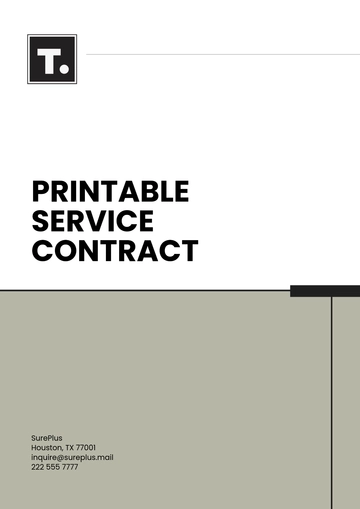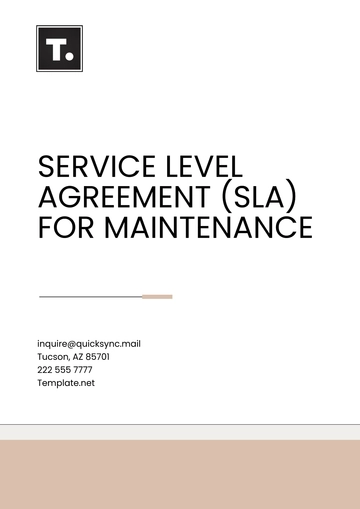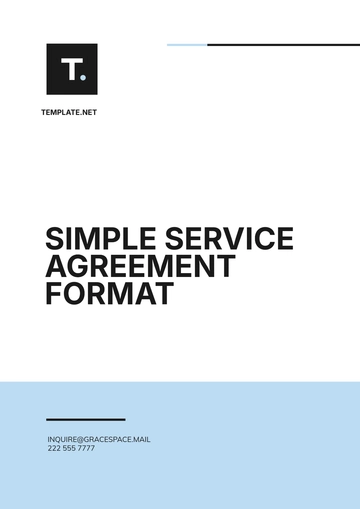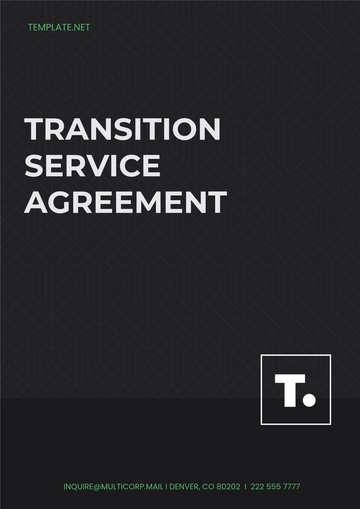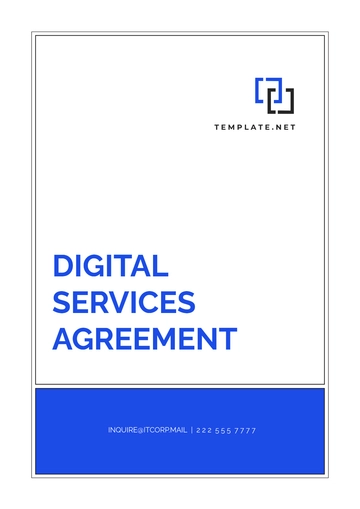Free Document on Post-Sale Service Level Agreements

I. Introduction to Post-Sale Service Level Agreements
This document will provide an overview of Post-Sale Service Level Agreements (SLAs), supported by statistical data, research findings, and real-world examples to underscore their importance in ensuring a seamless and satisfying customer journey.
A. Purpose of Post-Sale SLAs
SLAs define the commitments and expectations between a company and its customers. SLAs, in this context, serve as the cornerstone of a mutually beneficial relationship. They delineate the standards of service delivery and create a clear understanding of what customers can expect when they require assistance or support.
B. Objectives of Post-Sale SLAs
Setting Clear Expectations for Service Quality and Response Times:
One of the primary objectives of Post-Sale SLAs is to establish unambiguous expectations regarding the quality of service and the timeframes within which customers can anticipate resolution. This clarity is instrumental in mitigating misunderstandings and reducing potential friction in the customer-provider relationship.
Protecting the Interests of the Service Provider and the Customer:
Post-Sale SLAs serve as a two-way street, protecting the interests of both the service provider and the customer. While they assure customers of dependable service, they also provide companies with a structured framework to allocate resources efficiently, manage workloads, and deliver consistent support.
C. Scope of the Document
In this document, we will delve into the intricate details of Post-Sale SLAs, elucidating their scope and significance. We will outline what these agreements encompass and offer transparency by detailing their boundaries and limitations. By the end of this document, you will have a comprehensive understanding of the pivotal role Post-Sale SLAs play in shaping the customer experience and fostering long-term customer loyalty.
In the sections to follow, we will explore the components of Post-Sale SLAs, discuss best practices for drafting and implementing them, and provide insights into how these agreements can be a driving force behind the delivery of exceptional post-sale service. With the right Post-Sale SLAs in place, we can navigate the ever-changing landscape of customer expectations and reinforce our commitment to providing top-tier post-sale support.
II. Components of Post-Sale SLAs
It is imperative that we establish a robust framework that outlines the key components of Post-Sale SLAs. This section will delve into the essential elements that constitute a well-structured Post-Sale SLA, setting the stage for a clear and comprehensive understanding of how these agreements work and their role in delivering outstanding post-sale support.
A. Service Description
The cornerstone of any Post-Sale SLA is a detailed service description that elucidates the post-sale services offered to customers. This component serves as the foundation upon which all other aspects of the agreement are built. It provides customers with a comprehensive understanding of what they can expect in terms of post-sale support and assistance.
B. Performance Metrics and Standards
The second critical component of a Post-Sale SLA revolves around performance metrics and standards. This section defines the key performance indicators (KPIs) that will be used to evaluate the quality and efficiency of post-sale service.
C. Responsibilities and Duties
The final component of a comprehensive Post-Sale SLA delineates the roles and responsibilities of both the service provider and the customer. It spells out the obligations and requirements expected from each party to ensure a smooth and effective post-sale support process.
The components of Post-Sale SLAs are the building blocks of a successful and customer-centric post-sale support framework. By thoroughly describing the services offered, establishing clear performance metrics and standards, and defining roles and responsibilities, we not only provide transparency but also set the stage for a seamless post-sale customer experience.
III. Management and Measurement of SLAs
This section will delve into the vital aspects of managing and measuring SLAs, providing insights into how we track and improve our performance, communicate with stakeholders, and ensure that our post-sale support consistently meets or exceeds customer expectations.
A. Monitoring SLA Performance
Effective SLA management begins with the diligent monitoring of SLA performance. This component focuses on strategies for tracking and reporting SLA metrics, ensuring that we have a real-time understanding of how well we are meeting our commitments to customers.
Monitoring SLA performance involves using tools and technologies to track metrics such as response times, resolution times, and customer satisfaction scores. This data allows us to gauge our performance against the agreed-upon standards, identify areas of improvement, and take timely corrective actions.
B. SLA Reviews and Adjustments
The periodic review of SLA terms and conditions is essential to ensure that they remain aligned with changing customer needs and organizational goals. This component outlines procedures for conducting regular SLA reviews and mechanisms for making adjustments based on performance data and evolving requirements.
For instance, during a routine SLA review, we may discover that our response times for certain types of inquiries are consistently falling short of the agreed-upon benchmarks. In response, we can adjust the SLA to better reflect achievable response times or allocate additional resources to address the issue. This iterative process of review and adjustment is vital for maintaining the relevance and effectiveness of our SLAs.
C. Reporting and Communication
This component provides guidelines for reporting SLA performance to stakeholders, including both internal teams and customers. It also outlines communication protocols for handling SLA breaches or deviations.
In conclusion, the management and measurement of SLAs are integral to our mission of providing outstanding post-sale customer service. By diligently monitoring SLA performance, conducting periodic reviews and adjustments, and implementing clear communication protocols, we not only ensure that our post-sale support remains responsive and effective but also demonstrate our dedication to meeting or surpassing customer expectations.
IV. Issue Resolution and Escalation Procedures
This section will delve into the crucial aspects of incident management and escalation pathways, setting the stage for a comprehensive understanding of how we address and resolve customer issues effectively within the framework of our SLAs.
A. Incident Management
Incident management is the cornerstone of our commitment to resolving customer issues promptly and efficiently within the SLA framework. This component outlines the step-by-step process for handling service issues and the key contact points and communication channels that facilitate the reporting and resolution of these issues.
The incident management process would begin with the customer's initial contact, which may come through email, phone, or an online support portal. Our support team would then document the issue, assess its severity, and initiate a response in accordance with the SLA's defined response times.
B. Escalation Pathways
While our goal is to resolve all customer issues within the agreed-upon SLA terms, there may be situations where an issue requires escalation. This component outlines the defined escalation pathways for issues that cannot be resolved within the SLA's stipulated timeframes or according to its terms. It also clarifies the roles and hierarchy involved in the escalation process.
Defined escalation pathways not only demonstrate our commitment to addressing customer issues promptly but also provide a safety net for situations where immediate resolution is crucial. By clarifying the roles and responsibilities of those involved in the escalation process, we can ensure a coordinated and effective response to complex or time-sensitive issues.
In conclusion, issue resolution and escalation procedures are pivotal components of our post-sale customer service strategy. By implementing a structured incident management process and clearly defined escalation pathways, we not only address customer concerns within the SLA framework but also reinforce our commitment to responsiveness and accountability.
V. Legal and Regulatory Considerations
This section will delve into the critical aspects of compliance, amendment, termination conditions, and dispute resolution mechanisms, providing a comprehensive overview of how we ensure that our post-sale SLAs align with legal and industry standards while also addressing potential disputes effectively.
Service Parameter | Commitment | Notes / Conditions |
Initial Response Time | Within 24 hours of issue reporting | Applies to business days only |
Resolution Time | Within 4 business hours | Critical issues require immediate attention |
Customer Satisfaction Target | 90% satisfaction rating | Measured through post-resolution surveys |
Availability of Support | 24/7 for critical issues | Available during business hours |
Warranty Service Response | Within 3 business days | For products under warranty only |
On-Site Support Response | Within 48 hours | Only available in select regions |
Software Update Rollout | Quarterly updates | Frequently as needed |
Account Management | Dedicated account manager for premium clients | One business day response time |
Communication Updates | Bi-weekly status reports for ongoing issues | For issues not resolved within the initial response period |
Training and Documentation | Available upon request | Includes user manuals, FAQs, and access to online training |
A. Compliance and Standards
Ensuring compliance with legal, regulatory, and industry standards is paramount in the development and execution of post-sale SLAs. This component provides an overview of the various standards that influence our SLAs and underscores the implications of non-compliance with SLA terms.
B. Amendment and Termination Conditions
Flexibility is key in the world of SLAs, as circumstances and business needs can evolve over time. This component outlines the conditions under which our post-sale SLAs can be amended or terminated. It also provides insights into the process for renegotiation or dissolution of the SLA agreement.
Furthermore, the termination conditions are equally important. In some cases, it may become necessary to terminate an SLA due to a breach of contract or other unforeseen circumstances. Defining the process for termination and the associated consequences is crucial for protecting both parties' interests.
C. Dispute Resolution Mechanisms
Disputes related to SLA performance can arise, and having effective dispute resolution mechanisms in place is essential for addressing these issues promptly and fairly. This component outlines the processes for handling disputes, including arbitration and mediation procedures.
Effective dispute resolution not only protects our reputation and customer relationships but also demonstrates our commitment to fairness and accountability in our post-sale support processes.
By ensuring compliance with relevant standards, defining clear conditions for amendment and termination, and implementing effective dispute-resolution mechanisms, we not only safeguard our legal interests but also reinforce our commitment to transparency, fairness, and customer-centric service.
VI. Conclusion
This SLA is a testament to [Your Company Name]'s commitment to providing high-quality, reliable post-sale services, fostering long-term relationships with our clients, and continuously enhancing our service standards.
- 100% Customizable, free editor
- Access 1 Million+ Templates, photo’s & graphics
- Download or share as a template
- Click and replace photos, graphics, text, backgrounds
- Resize, crop, AI write & more
- Access advanced editor
Introducing Template.net's Document on Post-Sale Service Level Agreements, a guide to ensure optimum customer satisfaction. Professionally designed, this template is fully customizable and editable in our Ai Editor Tool, fitting exact client needs. Make a difference in your business through quality agreements. Break the mold, impress your clients, and foster a culture of excellence with our templates. Aim high, start now.
You may also like
- Lease Agreement
- Non Compete Agreement
- Rental Agreement
- Prenuptial Agreement
- Non Disclosure Agreement
- Operating Agreement
- Hold Harmless Agreement
- LLC Operating Agreement
- Arbitration Agreement
- Purchase Agreement
- Residential Lease Agreement
- Executive Agreement
- Confidentiality Agreement
- Contractor Agreement
- Partnership Agreement
- Postnuptial Agreement
- Collective Bargaining Agreement
- Loan Agreement
- Roommate Agreement
- Commercial Lease Agreement
- Separation Agreement
- Cohabitation Agreement
- Room Rental Agreement
- Child Custody Agreement
- Employee Agreement
- License Agreements
- Settlement Agreement
- Joint Venture Agreement
- Indemnity Agreement
- Subordination Agreement
- Sales Agreement
- Agreements Between Two Parties
- Business Agreement
- Real Estate Agreement
- HR Agreement
- Service Agreement
- Property Agreement
- Agreement Letter
- Restaurant Agreement
- Construction Agreement
- Finance Agreement
- Marketing Agreement
- Payment Agreement
- Investment Agreement
- Management Agreement
- Nonprofit Agreement
- Software Agreement
- Startup Agreement
- Agency Agreement
- Copyright Agreement
- Collaboration Agreement
- Reseller Agreement
- Car Rental Agreement
- Cleaning Services Agreement
- Consultant Agreement
- Deed Agreement
- Car Agreement
- Equipment Agreement
- Shares Agreement
- Data Sharing Agreement
- Advertising Agreement
- School Agreement
- Franchise Agreement
- Event Agreement
- Travel Agency Agreement
- Vehicle Agreement
- Board Resolution Agreement
- Land Agreement
- Binding Agreement
- Tenancy Agreement
- Exclusive Agreement
- Development Agreement
- Assignment Agreement
- Design Agreement
- Equity Agreement
- Mortgage Agreement
- Purchase and Sale Agreement
- Shareholder Agreement
- Vendor Agreement
- Royalty Agreement
- Vehicle Lease Agreement
- Hotel Agreement
- Tenant Agreement
- Artist Agreement
- Commission Agreement
- Consignment Agreement
- Debt Agreement
- Recruitment Agreement
- Training Agreement
- Transfer Agreement
- Apprenticeship Agreement
- IT and Software Agreement
- Referral Agreement
- Resolution Agreement
- Waiver Agreement
- Consent Agreement
- Partner Agreement
- Social Media Agreement
- Customer Agreement
- Credit Agreement
- Supply Agreement
- Agent Agreement
- Brand Agreement
- Law Firm Agreement
- Maintenance Agreement
- Mutual Agreement
- Retail Agreement
- Deposit Agreement
- Land Purchase Agreement
- Nursing Home Agreement
- Supplier Agreement
- Buy Sell Agreement
- Child Support Agreement
- Landlord Agreement
- Payment Plan Agreement
- Release Agreement
- Research Agreement
- Sponsorship Agreement
- Buyout Agreement
- Equipment Rental Agreement
- Farm Agreement
- Manufacturing Agreement
- Strategic Agreement
- Termination of Lease Agreement
- Compliance Agreement
- Family Agreement
- Interior Design Agreement
- Ownership Agreement
- Residential Lease Agreement
- Retainer Agreement
- Trade Agreement
- University Agreement
- Broker Agreement
- Dissolution Agreement
- Funding Agreement
- Hosting Agreement
- Investor Agreement
- Memorandum of Agreement
- Advisory Agreement
- Affiliate Agreement
- Freelancer Agreement
- Grant Agreement
- Master Service Agreement
- Parking Agreement
- Subscription Agreement
- Trust Agreement
- Cancellation Agreement
- Horse Agreement
- Influencer Agreement
- Membership Agreement
- Vacation Rental Agreement
- Wholesale Agreement
- Author Agreement
- Distributor Agreement
- Exchange Agreement
- Food Agreement
- Guarantee Agreement
- Installment Agreement
- Internship Agreement
- Music Agreement
- Severance Agreement
- Software Development Agreement
- Storage Agreement
- Facility Agreement
- Intercompany Agreement
- Lending Agreement
- Lodger Agreement
- Outsourcing Services Agreement
- Usage Agreement
- Assurance Agreement
- Photography Agreement
- Profit Sharing Agreement
- Relationship Agreement
- Rent To Own Agreement
- Repayment Agreement
- Volunteer Agreement
- Co Parenting Agreement
- HVAC Agreement
- Lawn Care Agreement
- SAAS Agreement
- Work from Home Agreement
- Coaching Agreement
- Protection Agreement
- Security Agreement
- Repair Agreement
- Agreements License


